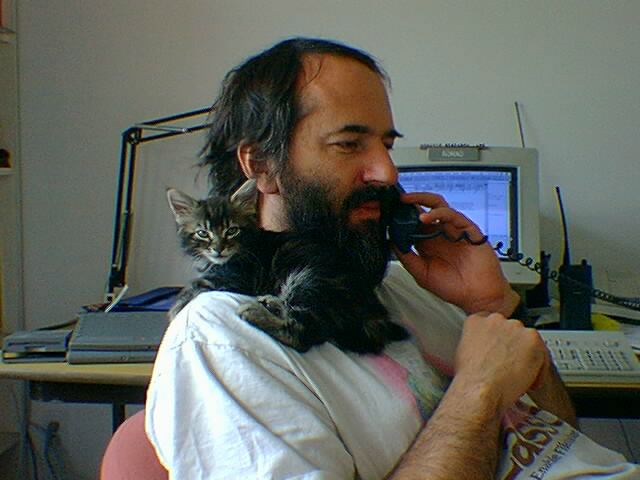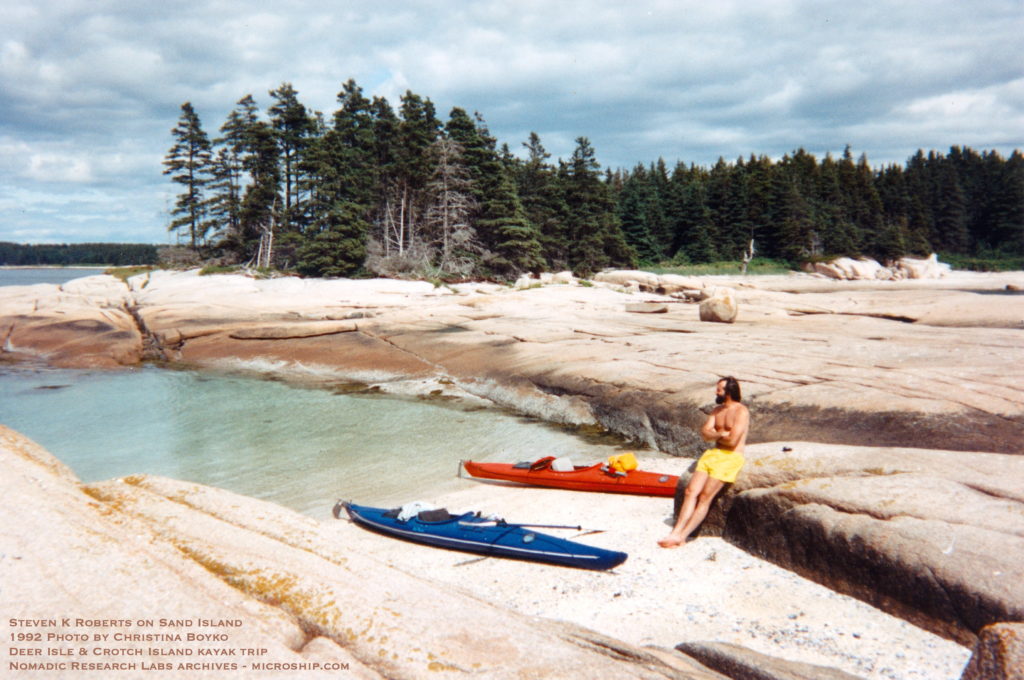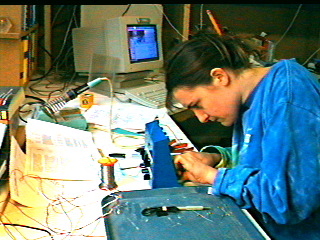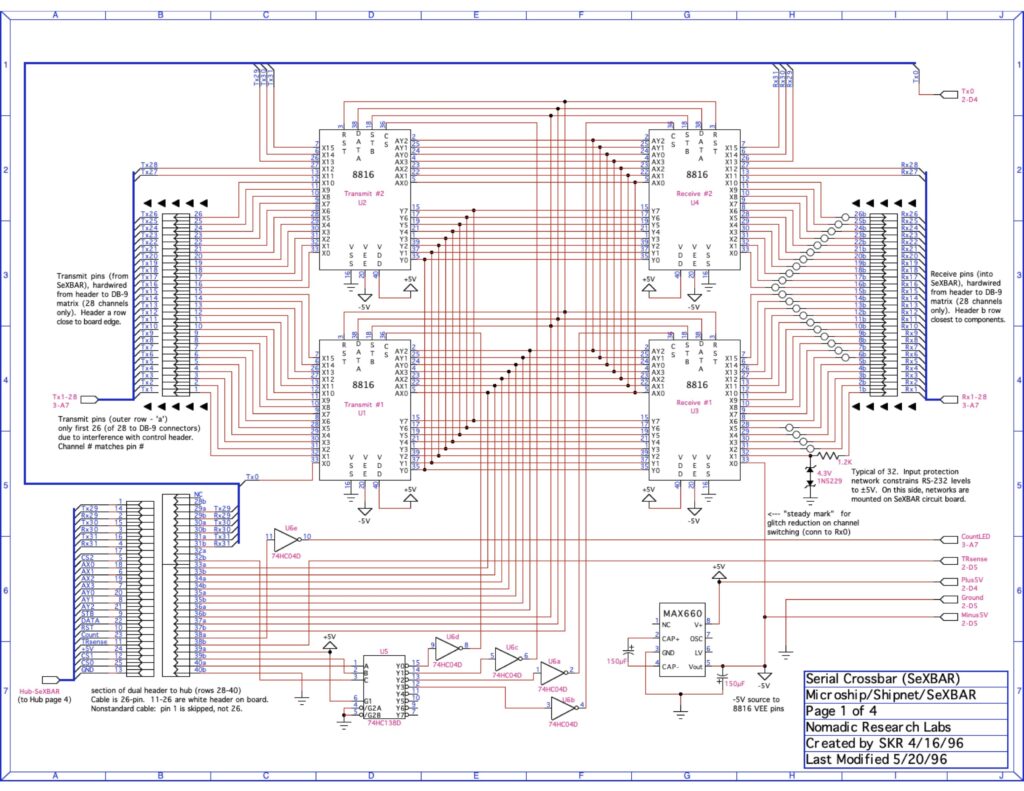
Previews of Coming Attractions
by Steven K. Roberts
Microship Status Report #128
Camano Island, Washington
January 12, 1999
“Audience: [frenzied drooling, scattering of folding metal chairs, a jumping up-and-down and careening around the room like baboons with electrodes in their pleasure centers running on a dry day in a freshly-carpeted room full of metal doorknobs]”
— excerpt from an ancient Nerdnosh posting by Dave Gross
Time, Time…
There’s a poignancy about it sometimes, this obsessive focus on a mad dream whilst all around me, life continues. Friends age. Babies get old enough to talk, then drive. My eyes are no longer perfect; my beard is streaked with gray; I watch people grow wealthy riding the coattails of IPOs and Internet stocks with unthinkable P-E ratios while my feeble bank account dwindles. And jeez, it’s 1999 already… we’re nearing the checkpoint of every half-assed article about the future we’ve ever read. “By the year 2000, we’ll all be flying personal helicopters, using videophones, and living in mile-high buildings made of miracle plastics…”
I was just reading a piece I wrote a decade ago, early in the throes of the 3.5-year BEHEMOTH project. Same crazy feeling… “standing in the window with a sore heart, watching the road go on without me.” Fresh from 16,000 miles of delicious adventure on the Winnebiko, I had flung myself into the dream of BEHEMOTH… the ultimate expression of technomadic geek bliss. I fondled the Ampro 286 processor board and Conner 40 Meg hard drive with something akin to awe, and having a 68000-based Macintosh Portable to repackage was on a par with conspicuous consumption, such a luxury was so much power in such a small package. But I was almost suffocated by endless details before at last hitting the road again, and by then my fantasies had already leapfrogged my reality: I yearned to move the whole adventure to water.

<creak> So here we are… what is it, a year since leaving Silicon Valley, six years into the Microship project, fifteen since I first pedaled out of Ohio? After all this time, all these labs, all these nautical substrates, and all this work, it’s just now beginning to feel real… albeit still vaporous, hypnagogic. I dare not fantasize overmuch about rollicking downriver, and I feel a bit furtive when I sneak the chartbook into the bathroom like a glossy skin magazine to gaze longingly at the pages, one at a time, my mind flowing over seductive benthic topography while I imagine probing estuarine crevasses heavy with the funk of low tide.
It’s really all about how we use our time, isn’t it? Aging is such a gentle wake-up call that you can sleep right through it, watch The Simpsons, have another beer, idly dream of projects, graffitize a passing thought onto the TO-DO list, and call that progress. The back’s a little too sore, the shop’s a little too cold; what the hell, it’ll keep, wouldn’t have gotten much done tonight anyway. But then you see an old friend who looks really old, and realize with a sudden shock that it’s happening to you as well. Damn. How did that happen?
Have you ever calculated how much time you spend watching TV (to pick an easy and obvious example)? A conservative estimate of 1.5 hours per night, year round, amounts over thirteen 40-hour work weeks per year! That’s more than one business quarter, or $25,000 of typical Silicon Valley high-tech employee overhead if you prefer to think in Human Resources terms. Add to that the relaxation time, meatspace maintenance, financial management, endless errands, and heaven forbid, the nightmare of commuting… no wonder anyone who gets anything done outside the structured framework of business is almost idolized. I look at these boatlets and cringe at the time wasted enroute… time forever lost in the phosphor vapors of pointless web surfing, the torpor of putzing, the relentless distractions of waiting on hold for customer service and chasing around to fix problems caused by institutional ineptitude.
It’s all easy to rationalize, but then, isn’t that the whole problem? It takes madness to pull off something like this; it takes crazed obsession, wild-eyed extremism, demonic focus… that hearty roaring piss ‘n vinegar of testosterone-infused youth. Lisa looks to me for guidance, and as the Senior Technomad here at NRL I buck up, scan the task lists, issue directives, dive into a project. It’s much harder than it used to be, but the Microship, now twice wet, hovers down there in the shop like a cruise missile, poised to deliver my explosively restless nomadic spirit to the hotbed of adventure… despite the fact that <red alert> I’m getting dangerously comfortable here.
The PCA Tour
And so, needing a kick in the pants and a healthy reminder of why I’m doing all this, I’ve given myself a public deadline. On the first clear weather window after April 15, I’ll launch a solo Previews of Coming Attractions tour around Puget Sound. This is the technomad’s equivalent to a trade-show deadline: announce a trip, make sure there’s a send-off party and a bit of media, then suddenly the pressure is on and somehow, against all odds, you actually get the thing ready in time. Such are the tricks we play on ourselves…
This mini-adventure should take 2-3 weeks, and will be a clockwise loop of the whole Puget Sound area from here south past Everett, into Seattle’s lakes, back out and around Bainbridge Island, down to Olympia, then north with a sweaty overland haul from Allyn to Belfair on the Hood Canal (I hope!), a long cruise up to Port Townsend, along the shore of Whidbey Island at the often-rowdy east end of the Strait, through Deception Pass (at slack, of course), and back to Camano Island headquarters… returning salt-encrusted from the sea to find — arrrrhh! — me lovely woman a-waiting on the porch. (“If you’re lucky,” she muttered upon reading this.)
All the mechanical and nautical systems have to be working for this, as well as enough basic power management to handle navlights, radio, and GPS. The console is still but a gleam in my eye and a partially-completed Masonite model, so this adventure will have to take place, somehow, without on-board Linux server and video production tools. The basic technological goal by launch is to have a working APRS tracking system installed, beaconing my lat-long every few minutes along with 3-4 telemetry channels (as well as packet-based email to stay in touch with Lisa and maybe even conjure a few postings from the genuine heart of nomadness rather than the clutter of a lab). The tracker will allow you, if you happen to care where I am at any given moment, to access a website that will display my current location in a MapBlast window.
If the government required this, I’d be among the first to revolt. But as a hobby, it’s way cool. Sick, eh?
Anyway, this gives us about 2.5 months to finish the landing gear, permanent pedals, rudder hydraulics, final rigging tweaks, basic power system, hopefully the solar module packaging, and enough camping and life-support facilities to allow bivouac both on and off the water. Route planning is depending heavily on the WWTA Cascadia Marine Trail campsites, as well as various friends, hostels, commercial campgrounds, marinas, and other facilities enroute. I welcome any suggestions and invitations… and there will be at least one more posting before departure to give you the tracker URL and other project specifics.
Hydraulic Rudder Controls
And so, in the foreground at the moment are a few fabrication jobs. One of the most amusing is the rudder control system, introduced in Issue #127. Since then, we have mounted the Clippard cylinders at the canoe stern, pivoting on aluminum brackets fashioned by Bob Stuart and coupled to the rudder yoke via clevis assemblies built from a modified Ronstan swivel. Amazing how even the most conceptually simple tasks require massive quantities of custom hardware…
At the cockpit end, the design has evolved considerably and is now a working cardboard (of course) model. I’m molding long flat fiberglass boxes about 4″ wide, one 6″ longer than the other and a bit wider. This rides over the smaller one on a pair of pricey stainless-steel drawer slide assemblies from Austin Hardware, forming an 18″ long padded armrest that can smoothly glide fore and aft over a 6-inch range. A hydraulic cylinder is mounted in the inner box, with its piston rod coupled through a bushing to the outer one. Voila… a rudder control, and one with lots of room for keyboards, pointing devices, and other user-interface goodies!
There are two closed systems coupling armrests to rudder, crossing the boat to make her turn in a logical direction and match the pistons properly (the rod reduces effective piston area on one side of a double-acting cylinder, which can cause all sorts of confusion). This provides redundancy in the event of any single point failure, and also makes the steering motion pleasantly symmetrical. Calibration is accomplished by a quartet of manual valves on the aft bulkhead, teed into the lines and connected via a manifold to a fluid reservoir. Just loosen the valves, center everything to balance the fluid quantities in each circuit, then tighten them all down.
The rudder uphaul and downhaul will also be hydraulic, with a blow-by valve to handle kickup from ground contact. All this apparent complexity eliminates four control lines that would otherwise have to follow direct paths from stern to cockpit, along with all the associated tensioners, sheaves, and cleats. Now it’s just part of the cabling harness, and disappears neatly under the deck.
MIMSY Update
The Linux server has been steadily developing, with the help of developers and Hummer pilots Brian Willoughby and Matthew Hixson. I’ve been HTML-ing a whole pile of system documentation, and Lisa’s even getting into the act with a Perl script sponsor logo display tool — the “electronic decal slide show” that will showcase our sponsors when the boat is on display (hey, the hull is too small for 116+ logos!).
The lab development environment has grown considerably, even as we expand our search for the micro-box that will be integrated into the boat itself. During the Northwest Geekfest party, Bob Donnell KD7NM donated a spacious disk drive for the 386 machine (which had previously been limited to 80 Meg — a pretty cramped Debian linux installation), and rebuilt the system around it. Ahhh, space. And then, in response to my plea in #127, Tony Loro of Nevada City earned a spot in the Sponsor/Volunteer Hall of Fame by shipping us a robust AST Server 486, saying “This was my old Digital Video editing rental machine, outdated for its work but still fast enough for your job.” This, once we get Linux installed, is destined to become the lab server and router (a number of people have pointed out that we can do all this with software and don’t need a separate box… once again, I am humbled by the collective experience, and willingness to share, of the people on this mailing list).
My profound gratitude to all for the help — the zone o’ hackage is now properly cluttered and alive with blinkies around the clock. We extended the lab Ethernet, and have started using the MIMSY server for backups, website development, and Microship Perl hacking!
Sponsors, Help, and Media
Speaking of new (to me) computers, I also want to thank Dewayne Hendricks for a most welcome hand-me-down PowerBook… I can finally get some work done at the house (just a distant flicker through the woods from the perspective of the lab, and then only in the winter when the trees are bare). We still don’t have any networking between the two sites and are lustfully eyeing wireless Ethernet, but it hasn’t been a problem so far… it’s just nice to be able to write on a decent computer in a cozier environment now and then.
GoLive (acquired this week by Adobe) donated a copy of CyberStudio for our website development, though we still don’t have a PowerPC-based Mac that can run it. <moan> The news from MacWorld about the new iMacs and G3’s causes deep pangs of longing, and I don’t even wanna TALK about how it feels to see Apple stock climb above 46 after I chickened out at 21. Duhhhh…
Thanks also go to Trace Engineering for a MicroSine Inverter — featured in the “guerilla solar” article in a recent issue of Home Power. This magical little box sits between a solar array and your utility power line, and as long as the latter is alive (for obvious safety reasons) it generates AC and contributes to the cause. Theoretically, this could even run your meter backwards, though with all the computers humming around the clock I doubt we’ll ever have a surplus! Also coming from Trace is a C40 charge controller… Tim Nolan and I have been discussing the trade-offs of doing all power management in our own software (conceptually simplest by far) versus having a trusted EMI-suppressed off-the-shelf black box that at least keeps our batteries happy even when all our homemade stuff has crashed. The trick here is that in the latter case, we have to instrument all around it so our own algorithms know what’s going on.
And venerable PAiA Electronics, purveyor of wonderful synthesizers and audio-hacking tools since the early 70’s, has become one of our sponsors as well… in the form of a Theremax theremin. Lisa worked with theremins in her days as an art-techie and laser-babe in London, using various MIDI hacks to control exhibits with gestural input. In the Microship environment, she wants to experiment with quantizing the theremin channels and using gestural channel selection for on-the-fly video editing, and I want to play with handwaving as an alternative control input for the autopilot. If nothing else, the musical implications should be amusing in their own right… I can see us eerily echoing in the moonlight through deep canyons, spooking the loons and raising gooseflesh on the necks of slumbering campers…

Motorola is shipping a care package of TalkAbout radios and accessories — more on those after they’ve arrived and we’ve had a chance to try them! We need continuous pack-to-pack voice communication, illegal with Marine VHF and constrained by content and style protocols in the ham bands.
Steve Orr sent the latest version of his utterly amazing LifeTime clock, a 68HC05-based wonder that animates a matrix of 210 green LEDs with dozens of imaginative and sprightly time displays… often using the numerics as the seed for Conway’s “Life” algorithm. This version even has Z-axis control, and makes watching the clock even better than TV. I’m urging him to market this as a kit… it is definitely the ultimate geek clock.
In the volunteer department, hats off to Karen Adams, from whom we bought this house, for sanding help before the first-pass paint job… the boat is gleaming now, finally looking like one thing instead of a million little things glued together. Also, a jittery toast to Brian Willoughby who donated a coffee maker for the party and decided to leave it as an alternative source of coding fuel (latte and chai are so labor-intensive). Paul Elkins, tubing-bending wizard and builder of eccentric tiny boats, is getting involved in the crank project. And Bill Vodall spent an afternoon helping string an end-fed longwire antenna into the woods, dangling off the automatic tuner designed by Dwayne Kincaid, WD8OYG, and published in QST. I haven’t really put it through its paces yet, but I did have a few easy QSO’s on the low bands… and Lisa quickly found BBC.
There’s been a bit of media since our last update — a local-angle piece in the Stanwood/Camano News, as well as a one-pager in the December issue of Home Office Computing. CQ VHF bought one of our unpardonable wordplay cartoons and has it slated for the February issue, and I’m working on articles for Sail Magazine and Dr. Dobbs Journal…
BEHEMOTH in Silicon Valley Next Month!
Finally, I’d like to announce another road trip — this one back to familiar haunts. I have a speaking gig in Monterey in early February, thanks to the Keynote Speakers bureau, and that will have us rumbling around Silicon Valley in the Mothership with BEHEMOTH in tow. I’ve been kicking myself for years for not making a real point of arranging some on-site corporate appearances in the bike’s birthplace, and here’s your chance to help.
If you work for a company in the Bay Area, or have good contacts at same, I’m inviting you to become my agent in arranging a talk. I’ll pay 15% of the appearance fee (unless your position would give this the flavor of a conflict of interest, in which case I’ll just thank you warmly and buy you a beer). In any case, what I’m trying to accomplish here is a whirlwind tour of the Valley, taking the bike on stage for brown-bags or other flavors of in-house presentations to technical audiences. It’s guaranteed to be amusing, and maybe even thought-provoking — with BEHEMOTH on stage, the talk covers bike systems, road adventures, humor, and a detailed look at the Microship design. There’s a list of previous gigs on our website, and at the moment the schedule is flexible for anytime in the first two weeks of February.
While I’m wearing this funny-looking marketing hat, I should also mention that (armed with our whizzy new Ibico comb binding machine) we’ve resumed the publication of monographs, and just finished one on the design of our Serial Crossbar Network (Sexbar) — as well as another that compiles all the 89-93 Nomadness journals into one book. I’m not going to turn this posting into spammage, however, so I’ll just say that if you’re interested in this or any others in the series, please write for details.
With that, I’m off to work on the tracker… everything for the PCA Tour will be built into a yellow waterproof Pelican box and I can’t wait to start drilling holes, then filling them in again!



You must be logged in to post a comment.